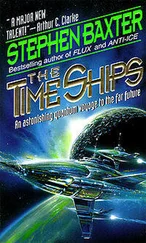The “lightsail” is in fact an interstellar propulsion technology whose underlying principles were, remarkably, defined and demonstrated by the end of the nineteenth century, with a theoretical prediction of the pressure exerted by light by the Scottish physicist James Robert Maxwell, followed by an experimental demonstration by a Russian scientist called Peter Lebedev in 1900. Later the American physicist and science fiction writer Robert L. Forward did much to develop the idea. In his novel Rocheworld Forward described a manned starship propelled by the collected light of a thousand laser stations in orbit around planet Mercury. But the basic idea is more elegant, even beautiful; if you didn’t mind a journey time of a few thousand years you could sail to the stars powered by sunlight alone, pushing a huge, filmy sail.
Pushed by the energy beam, Venture Star accelerates at an uncomfortable (for the awake crew) one and a half gravities for a hundred and sixty-eight days. Then it cruises. Jake Sully, having slept away the journey to Alpha Centauri in cryosleep, is told on waking that the journey took five years, nine months and twenty-two days. That’s certainly a long enough time to justify putting most of the passengers in the freezer rather than try to keep them fed, watered and occupied all that way; an active human consumes around two tonnes per year of oxygen, water and food.
But it’s still a pretty rapid crossing. According to my venerable Norton’s Star Atlas, Alpha Centauri is 4.39 light years from the sun. Despite a perhaps confusing name, a “light year” is a unit of distance, not time; it’s the distance a light beam travels in a year, around nine trillion kilometres, or about sixty thousand times the distance between Earth and sun. So it would take a beam of light four years, four months and around nineteen days to reach Alpha Centauri. Any estimate of the ship’s precise speed depends on whether Jake’s five years, nine months and twenty-two days is measured on Earth or aboard the ship—as we’ll see, there is a difference! But you can see immediately that to cross more than four light years in less than six years Venture Star must have been travelling at a respectable fraction of the speed of light. In fact, the cruise speed is seventy per cent of lightspeed, and the ship travels at this speed for five years ten months.
Such a high velocity immediately raises another hazard: interstellar debris. Space isn’t empty, not even between the stars. Out there between the sun and Alpha Centauri the average density of matter is around one hydrogen atom per cubic centimetre. That may not sound a lot, and in the four-light-year-long tunnel bored by Venture Star the ship will only encounter a gram or so of material. But a gram hitting you at seventy per cent lightspeed would be equivalent to the three hundred tonnes of the International Space Station hitting you at Earth-orbital speeds—whammo! So after launch the ship is turned head over heels, so that during the cruise those mirror shields that protected the crew from the laser beam are held ahead of the craft, to act as multi-layer protection against the debris.
As Alpha Centauri approaches, the ship is flipped over again and the great antimatter engine is at last fired up, burning to give a deceleration of one and a half gravities for another hundred and sixty-eight days. On return to Earth, the sequence is reversed, with the antimatter engine pushing Venture Star on its way, and the beamed-energy laser bank slowing it down at the solar system. (Incidentally many candidate designs for starships use hybrid designs like Venture Star , with more than one propulsion system; the huge distances involved push our technologies to the limit.)
How long does the journey take? Well, if you add up all the times I quoted above you’ll find the total one-way mission duration, including acceleration, cruise and deceleration, is about six years and nine months—
Wait. Jake Sully was told he’d been sleeping for five years, nine months and twenty-two days. That’s a discrepancy of a year. What’s gone wrong?
The reason these numbers are different is because of another aspect of that tremendous velocity, those vast distances, that no amount of ingenuity will let you engineer away: relativity.
The timestamp on Jake Sully’s video diary tells us that his adventure among the Na’vi begins in May of the year 2154. But if Jake’s image were beamed directly to Earth—at lightspeed, the fastest possible—it wouldn’t arrive for another four years, four months; his May 2154 journal entry couldn’t be read until September 2158.
Even our nearest neighbour the moon is a bit more than a light-second from Earth. The two-second round-trip delay was noticeable during communications between Houston and the Apollo astronauts. This made little practical difference for Apollo, but it would for RDA on Pandora. It would take a whole four years for a plea for orders from Hell’s Gate administrator Parker Selfridge to reach his superiors back on Earth, and four more years for any reply to come back. Until an effective faster-than-light communicator is invented (see Chapter 11), interstellar colonialism will be much like empires on Earth before the advent of the telegraph and radio, when messages from London, carried overland or by ship, could take weeks or months to reach British outposts in India or Australia. (In fact RDA is rather like the East India Company, used by the imperial British to subdue that subcontinent and open up its resources; the London government profited through taxes while letting private enterprise take the strain.) And, just as in imperial days, because of lightspeed delays interstellar colonial administrators will enjoy a great deal of autonomy—a situation that can go horribly wrong.
But there’s more to lightspeed and time than this kind of administrative challenge. If it’s 19 May 2154 at Alpha Centauri, what’s the date on Earth?—which is, after all, more than four light years away. Come to that, what time is it on the moon right now ? If Charlie Duke, who worked as ground communicator at Houston during the landing of Apollo 11, had tried to synchronise his watch with Neil Armstrong’s on the moon, there would have been a comedy of errors as Duke’s “Mark!” reached Armstrong’s ears a whole second later, with Armstrong’s own “Mark!” coming back to Earth a second after that.
I suppose Duke and Armstrong could have agreed between themselves that Houston time is the “master,” and any records made by Armstrong and Aldrin on the moon could reflect this. Perhaps in the Avatar universe some such administrative arrangement will be made, so that on Jake’s video-record time stamps a date of 19 May 2154 as recorded on Pandora will have an unambiguous meaning, whoever’s viewing it, on Earth or Pandora. Similar reconciliations have been made in the past. In the nineteenth century the coming of the railways, and the need to draw up timetables everybody could agree on, inspired the first moves to set up national time frames. In Britain, for a long time, the official time was called “railway time.”
But that’s just bureaucracy. There’s something more fundamental here. When is it “really” 19 May—when it comes up on the calendars on Earth, or on Pandora? Is there some universal time frame we can all appeal to? Can we synchronise our local times by the ticking of some cosmic clock?
Unfortunately (or wonderfully, depending on your point of view) the universe we live in is stranger than that. Albert Einstein proved that not only is there no universal time frame, there isn’t even a universal rate at which time passes. This is all because of relativity.
Читать дальше










